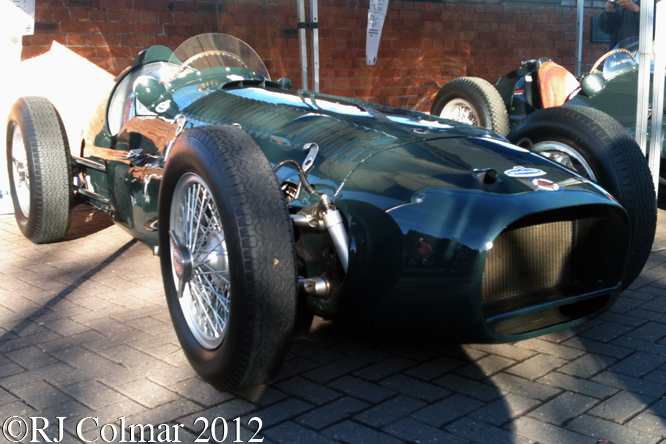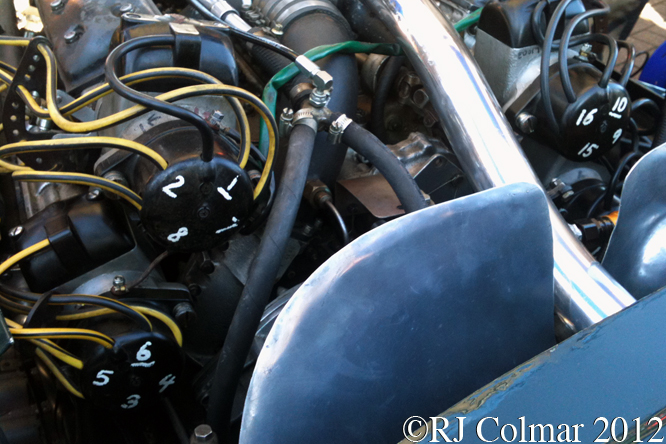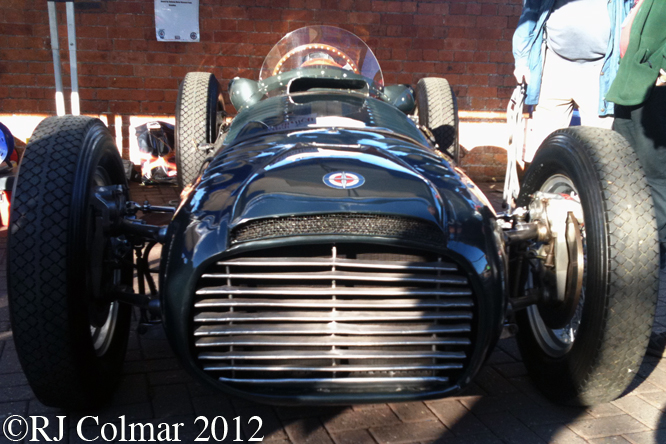V16 BRM
#1

Posted 25 April 2000 - 05:04
I have heard it said, I think by tony Rudd in his autobiography, that the problem would have been overcome if the car had used the vortex throttle system that was designed for it.
Now, I think I know what a vortex is, and I certainly know what a throttle is, but I can't imagine what a vortex throttle is, nor how it would have helped the V16. Also, why was it not used?
Advertisement
#2

Posted 25 April 2000 - 05:18
More on this subject would be most interesting... just imagine driving the thing, 250bhp through a sweeper turning to 500bhp as the revs rose by 600rpm!
------------------
Life and love are mixed with pain...
#3

Posted 25 April 2000 - 11:10
------------------
Regards,
Dennis David
Grand Prix History
Life is racing, the rest is waiting
#4

Posted 25 April 2000 - 14:49

#5

Posted 26 April 2000 - 00:51
As far as the vortex throttle is concerned, I was wrong about it's being mentioned in Rudd's book. I've looked through the "usual suspects" (Pomeroy, Jenkinson and Nye) but the only mention I found is in Leonard Setright's "The Grand Prix".
Apparantly the system was designed by R-R and was intended to keep boost pressure constant at over 10,000rpm. THis would enable higher perssure to be used at lower revs and would overcome the problem of a steeply rising torque curve.
#6

Posted 26 April 2000 - 05:10
Not good enough to get the press, hence the money to keep going...
------------------
Life and love are mixed with pain...
#7

Posted 26 April 2000 - 09:01
------------------
Regards,
Dennis David
Grand Prix History
Life is racing, the rest is waiting
#8

Posted 22 January 2003 - 21:07
Originally posted by Roger Clark
As far as the vortex throttle is concerned, I was wrong about it's being mentioned in Rudd's book. I've looked through the "usual suspects" (Pomeroy, Jenkinson and Nye) but the only mention I found is in Leonard Setright's "The Grand Prix".
Apparantly the system was designed by R-R and was intended to keep boost pressure constant at over 10,000rpm. THis would enable higher perssure to be used at lower revs and would overcome the problem of a steeply rising torque curve.
I don't apolgise for digging out this thread....people have arrived since Roger started it.
I have read about the vortex throttle with respect to the V16 BRM somewhere recently, and wondered what the heck it was...would have sworn it was in the Tony Rudd book.
So....of what did the R-R system consist?
I have the little Rivers Fletcher book about the V16- the one with all the cutaway drawings on film that overlay each other. These words are included from Pomeroy....
"Fuel is supplied by mechanical pumps to a pair of specially developed SU carburettors, early experiments with fuel injection into the eye of the supercharger impeller having proved abortive"
Relevant?
#9

Posted 22 January 2003 - 22:53
DCN
#10

Posted 22 January 2003 - 23:09
Originally posted by Doug Nye
OK - none of you have been reading the right books - the original fuel-injection idea incorporated an iris-type throttle - like the adjustable-aperture iris in a camera, and it was judged contemporarily to be "beyond the development capability of the team in terms of time, money and men". I drove a Mark II and I spun it when trying to provoke a slide - the very instant the rear tyres broke traction I was lost in a world of runaway revs and wheelspin, a cacophony of noise and a blurr of rotating scenery... Ooh I felt such a prat...
DCN
A prat?...when Moss said it was the worst car he had ever driven?
So is this iris thingy a vortex throttle?
#11

Posted 22 January 2003 - 23:29
It was part of the original master-scheme devised by Rolls-Royce supercharger specialists Prof Allen and 'Oscar' Wilde of the Compressor Section of R-R's Experimental Department, and approved by Lord Hives of R-R for the BRM project by February 1947.
It comprised an array of nine vanes introduced into the supercharger intake, each of which could swivel about its individual perpendicular axis to vary swirl as it entered the impeller stage. These swirl vanes were to be actuated automatically by a servo piston controlled by boost pressure or engine speed.
Below 9,000rpm these vanes would present edge-on to the intake flow to create negligible pressure loss, but above 10,000rpm they would swivel progressively to swirl the incoming mixture in the same direction of rotation as the adjacent - fast rotating - impeller blades.
Reducing the mixture's change of angular momentum through the impellers lowered the temperature rise and pressure ratio achieved. Ahead of these vanes was a butterfly throttle controlled in the normal manner by the driver. Although the 'eye of the supercharger' SU fuel injection and vortex throttle system were both manufactured neither would ever be raced.
There's a bloody brilliant book which describes all this...
DCN
#12

Posted 22 January 2003 - 23:31
Originally posted by Doug Nye
OK - none of you have been reading the right books
Well, I've been reading Trieste and the Meaning of Nowhere by Jan Morris and she doesn't appear to have addressed the issue of vortex throttling in any meaningfuil way.
#13

Posted 22 January 2003 - 23:33
#14

Posted 22 January 2003 - 23:41
Originally posted by Doug Nye
Touche, as they say in the Isle of Wight...thank you Roger...
Blimey. Thankyou Doug and Roger. I suppose the V16 was complicated enough without that lot. Ingest one gnat and the whole shooting match would jam up?
#15

Posted 22 January 2003 - 23:59
Originally posted by Roger Clark
Well, I've been reading Trieste and the Meaning of Nowhere by Jan Morris and she doesn't appear to have addressed the issue of vortex throttling in any meaningfuil way.
Vortex throttling has something to do with sex changes??? (yes...been Googling!;) )
#16

Posted 23 January 2003 - 01:29
#17

Posted 07 February 2010 - 15:59
http://thechicaneblo...rm-v16-lecture/
#18

Posted 08 February 2010 - 04:31
...It was part of the original master-scheme devised by Rolls-Royce supercharger specialists Prof Allen and 'Oscar' Wilde of the Compressor Section of R-R's Experimental Department, and approved by Lord Hives of R-R for the BRM project by February 1947....
DCN
Did Stanley (later Sir Stanley) Hooker play no part in this then? Maybe he was by then too occupied with gas turbine aircraft engines ...?
#19

Posted 08 February 2010 - 08:35
When he got to Bristol Engines, they presented him with the prototype Proteus, saying that the design brief was to create the most powerful gas-turbine in the world regardless of weight : the engineers mournfully reported "So far, we have achieved the weight target ....".
SGH was an all-round Brit genius engineer and also the man who rescued the RB211 from extinction when it had bankrupted RR in 1971.
Nick
Did Stanley (later Sir Stanley) Hooker play no part in this then? Maybe he was by then too occupied with gas turbine aircraft engines ...?
[/quote]
Advertisement
#20

Posted 08 February 2010 - 08:59
#21

Posted 02 May 2013 - 12:37
The orifices are visible in all photographs of the cars until the 1952 British Grand Prix when they first appeared with larger radiators and a blister over the top of the grill. Were the cars push-started after that?
I've looked through the V16 books by Doug Nye, Karl Ludvigsen and Anthony Pritchard but didn't find the answer - it is quite possible that I missed it. Incidentally, Doug's Saga contains (page 406) a picture of the car at the 1950 British Grand Prix with the shaft on the wrong side - presumably a reversed photograph.
#22

Posted 02 May 2013 - 13:36
In its early days, the V16 engine was started by a electric motors attached to a shaft which emerged through an orifice on the top of the nose. This orifice was not present when the car was first presented to the press but it was clearly present by the time of the demonstration at the 1950 British Grand Prix. The shaft is clearly too high to connect directly to the crankshaft but it seems to be about right for an inlet camshaft. Is this how it was done, or was there an indirect connection to the crankshaft?
The orifices are visible in all photographs of the cars until the 1952 British Grand Prix when they first appeared with larger radiators and a blister over the top of the grill. Were the cars push-started after that?
I've looked through the V16 books by Doug Nye, Karl Ludvigsen and Anthony Pritchard but didn't find the answer - it is quite possible that I missed it. Incidentally, Doug's Saga contains (page 406) a picture of the car at the 1950 British Grand Prix with the shaft on the wrong side - presumably a reversed photograph.
Just to throw a little mud into the waters, here's Ken Wharton at Shelsley in 1953 - I assume that's the orifice in question (left hand side of the scoop or blister as we look at it)?

(Image copyright Classic Cars Archive)
#23

Posted 02 May 2013 - 13:59
Edited by Belmondo, 02 May 2013 - 13:59.
#24

Posted 02 May 2013 - 14:39
In its early days, the V16 engine was started by a electric motors attached to a shaft which emerged through an orifice on the top of the nose. This orifice was not present when the car was first presented to the press but it was clearly present by the time of the demonstration at the 1950 British Grand Prix. The shaft is clearly too high to connect directly to the crankshaft but it seems to be about right for an inlet camshaft. Is this how it was done, or was there an indirect connection to the crankshaft?
Sounds like a tail trying to wag its dog!
#25

Posted 02 May 2013 - 14:59
Is that not a lucky horseshoe mascot affixed to the mesh, Tony?I assume that's the orifice in question (left hand side of the scoop or blister as we look at it)?
#26

Posted 02 May 2013 - 15:41
#27

Posted 02 May 2013 - 16:19
It looks to me that there is mesh in the 'hole'.
You're right about that, and it's rather a small shoe as well, maybe it's off 'My Little Pony'.
No ear defenders in evidence, but plenty of hands clamped over ears.
#28

Posted 02 May 2013 - 16:37

Looking at that exhaust pipe and seeing how close the spectators were in the previous pic, small wonder they had hands over their ears.
Edited by kayemod, 02 May 2013 - 16:40.
#29

Posted 02 May 2013 - 16:43
DCN
Edited by Doug Nye, 02 May 2013 - 16:44.
#30

Posted 02 May 2013 - 16:51
#31

Posted 03 May 2013 - 00:08
In its early days, the V16 engine was started by a electric motors attached to a shaft which emerged through an orifice on the top of the nose. This orifice was not present when the car was first presented to the press but it was clearly present by the time of the demonstration at the 1950 British Grand Prix. The shaft is clearly too high to connect directly to the crankshaft but it seems to be about right for an inlet camshaft. Is this how it was done, or was there an indirect connection to the crankshaft?
The orifices are visible in all photographs of the cars until the 1952 British Grand Prix when they first appeared with larger radiators and a blister over the top of the grill. Were the cars push-started after that?
I've looked through the V16 books by Doug Nye, Karl Ludvigsen and Anthony Pritchard but didn't find the answer - it is quite possible that I missed it. Incidentally, Doug's Saga contains (page 406) a picture of the car at the 1950 British Grand Prix with the shaft on the wrong side - presumably a reversed photograph.
A couple of pics of P18/1 (according to the BRM Day Prog)

with the orifice at the top of the nose,

however there is no evidence of any starter drive connection to the camshafts,

which are all otherwise engaged in driving 4 magnetos.
BRM mechanics from the period recall Ken Wharton as always wanting to drive Fangio's car, whenever Fangio wasn't competing. He identified Fangio's car by the horseshoe attached to the intake mesh. So they simply swopped the horseshoe onto whichever car PB might assign to him. If he saw that in place, he seemed to be a happy driver.
DCN

I suppose given that Juan and Ken are no longer with us nobody sees the point of keeping a horseshoe on P15/1 for old times sake
Edit: misidentified these two cars when this entry was originally posted, they should now be the right way round
Edited by arttidesco, 03 May 2013 - 19:05.
#32

Posted 03 May 2013 - 08:36
Somewhere I have that V16 book with beautiful cutaways on clear cells overlaying other cutaways. Wonder if that would show the starting mechanism (if any)?
#33

Posted 03 May 2013 - 09:07
Somewhere I have that V16 book with beautiful cutaways on clear cells overlaying other cutaways. Wonder if that would show the starting mechanism (if any)?
I am sure the venerable Mr Nye will jump in and correct me but I seem to remember that the mechanism was inserted in the side of the car just ahead of the driver?
#34

Posted 03 May 2013 - 09:31
#35

Posted 03 May 2013 - 09:44
I've justhad a look at my V16 book and there is no sign or mention of the starter mechanism. It may be in the body of the text, but nothing on the transparent overlay illustration. Of course, with a distributor on the nose of each camshaft it would be 'difficult' to use a camshaft for turning the engine over, but the starter shaft (if that is what it is) in the cutaway above is heading towards the timing gears, so perhaps that is the connection.Somewhere I have that V16 book with beautiful cutaways on clear cells overlaying other cutaways. Wonder if that would show the starting mechanism (if any)?
#36

Posted 03 May 2013 - 10:46
I think that's right. A drive to the centre of the engine could, as Tony Matthews says, connect to the timing gears or to the power take-off. There's a photograph in Anthony Pritchard's BRM V16 In Camera (page 124) which supports this.Here's a Theo Page cutaway as posted by Macoran in the cutaways thread. Open the thumbnail then enlarge the resulting Imageshack image by clicking on the 'Zoom' icon. The starter drive can then clearly be seen, and as Arttidesco says, it doesn't seem to be heading towards a camshaft but to somewhere in the centre of the 'V':
#37

Posted 03 May 2013 - 10:47
I don't remember that on a V16. Any evidence?I am sure the venerable Mr Nye will jump in and correct me but I seem to remember that the mechanism was inserted in the side of the car just ahead of the driver?
#39

Posted 03 May 2013 - 12:03
Advertisement
#40

Posted 03 May 2013 - 12:22
Nick Mason's Mk2 was built from Mk1 15/1 ;)
The BRM Day Prog says P15 Mk 1 V16 (P15/1) Owner Beaulieu NMM
If this is not correct please do not hold back
#41

Posted 03 May 2013 - 13:23
The BRM Day Prog says P15 Mk 1 V16 (P15/1) Owner Beaulieu NMM
If this is not correct please do not hold back
I believe the NMM car is 15/2
But I also think the car in the photo looks more like a Mk2
#42

Posted 03 May 2013 - 15:29
So,I believe the NMM car is 15/2
But I also think the car in the photo looks more like a Mk2
There were three Mark1s
15/1 became Nick Mason's Mark 2
15/2 is the NMM Mark 2
15/3 was written off by Wharton at Albi in 1953 and parts were used in the first Mark 2.
Doesn't make sense to me.
I thought the car pictured by Artidesco was the one purchased by Tom Wheatcoft in the 1981 auction and pictured on page 413 of Doug Nye's book with Phil Hill driving. That is certainly a Mark 2.
#43

Posted 03 May 2013 - 19:02
So,
There were three Mark1s
15/1 became Nick Mason's Mark 2
15/2 is the NMM Mark 2
15/3 was written off by Wharton at Albi in 1953 and parts were used in the first Mark 2.
Doesn't make sense to me.
I thought the car pictured by Artidesco was the one purchased by Tom Wheatcoft in the 1981 auction and pictured on page 413 of Doug Nye's book with Phil Hill driving. That is certainly a Mark 2.
Just had a look at the Madasfish V16 page, my mistake I have got the Mk1's and Mk 2's completely mixed up
The top three pix in post #31 of this thread are indeed of Kevin Wheatcrofts Mk 2 car and the bottom one is the Beulieu NMM Mk 1 (according to the BRM Day Prog)
#44

Posted 05 May 2013 - 17:49
Looking at the Christie's catalogue for the BRM sale, the Mk2s which were sold were described as:There were three Mark1s
15/1 became Nick Mason's Mark 2
15/2 is the NMM Mark 2
15/3 was written off by Wharton at Albi in 1953 and parts were used in the first Mark 2.
Doesn't make sense to me.
I thought the car pictured by Artidesco was the one purchased by Tom Wheatcoft in the 1981 auction and pictured on page 413 of Doug Nye's book with Phil Hill driving. That is certainly a Mark 2.
Lot 53: "1954 BRM P30 1½ litre V16 Single Seater ("Mark ll")" Chassis no: 2/01 Engine no: 20/2 Gearbox no: 002
Lot 54: "1954 BRM P30 1½ litre V16 Single Seater ("Mark ll")" Chassis no: 2/02 Engine no: 20/3 Gearbox no: 004
They are both described as being completed in March 1954 and cassis 2/01 first appeared at Goodwood on 19-4-54 while 2/02 made its debut at Aintree on 31-5-54
The listing for the Mkl is:
Lot 55: "1950 BRM Type 15 1½ litre V16 Grand Prix Single Seater" Chassis no: 1/01 Engine no: 20/1 Gearbox no: 001
#45

Posted 07 May 2013 - 07:29
#46

Posted 20 June 2013 - 13:36
Mk1 P15/1 as owned by NMM
Mk2 P30/1 1954 sprint car using parts from Mk1 P15/2 - current owner?
Mk2 P30/2 1954 using part from Mk1 P15/3 - current owner?
Mk1 P15 reconstruction by Hall & Hall for Tom Wheatcroft - possibly using some of the chassis frame of P15/2? It was painted in the early pale green colours.
Also some years ago Tom Wheatcroft was seen driving a dark green Audi Saloon on the M1 with the registration V16 BRM! Does that make 5?
Edited by Concreteconrods, 22 June 2013 - 13:02.
#47

Posted 20 June 2013 - 14:06
Similar to Alan Cox's post to the best of my knowledge there are four V16 BRM's in existence: -
Mk1 P15/1 as owned by NMM
Mk2 P30/1 1954 sprint car using parts from Mk1 P15/2 - current owner?
Mk2 P30/2 1954 using part from Mk1 P15/3 - current owner?
Mk1 P15 reconstruction by Hall & Hall for Tom Wheatcroft - possibly using some of the chassis frame of P15/3? It was painted in the early pale green colours.
Also some years ago Tom Wheatcroft was seen driving a dark green Audi Saloon on the M1 with the registration V16 BRM! Does that make 5?
And Kevin confirmed to me at Cholmondeley that H&H are building 3 new V16 engines but with some hidden modern tweaks to make sure they continue to run, particularly to produce the right sparks at the right time.
Chris
#48

Posted 20 June 2013 - 21:10
Nick Mason's Mk2 was built from Mk1 15/1 ;)
Are both statements correct?Similar to Alan Cox's post to the best of my knowledge there are four V16 BRM's in existence: -
Mk1 P15/1 as owned by NMM
#49

Posted 21 June 2013 - 07:33
DCN
#50

Posted 21 June 2013 - 08:58
























